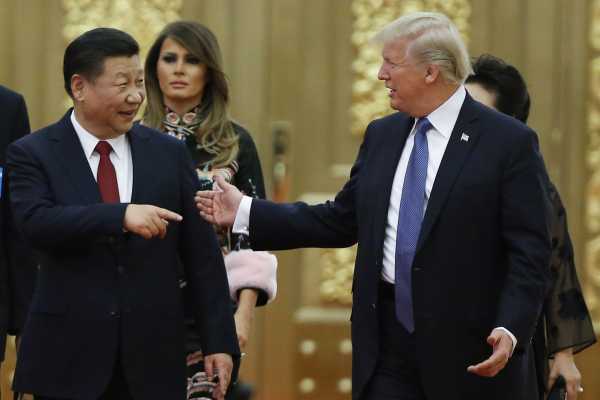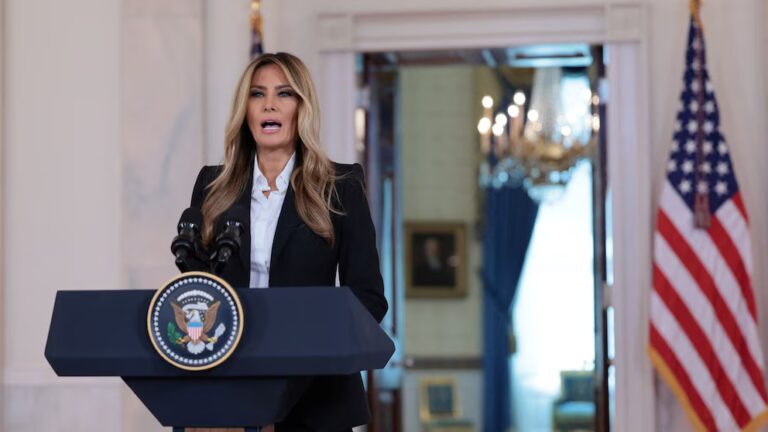
The burgeoning US-China trade war isn’t impossible to stop, it’s just that there’s no clear way of ending it — especially because it’s not obvious what President Donald Trump wants out of all of this in the first place, or what China is willing to give.
The United States just after midnight on Friday made good on its threat to impose sweeping tariffs on Beijing, putting a 25 percent border tax on $34 billion worth of Chinese goods imported to the US. China responded with $34 billion of tariffs of its own on its imports from America.
The tariffs and counter-tariffs mark the start of a trade war for which there’s no obvious end. Worst-case scenario: It results in a series of measures and counter-measures that could have a major negative impact on consumers and global economies. Best-case scenario: The sides reach some sort of an agreement, and it ends.
I spoke with multiple experts to ask whether there’s still an off-ramp in the US-China trade standoff, or if we’re hurtling toward an unstoppable and sustainable trade war. The general consensus: There’s always an off-ramp, but it’s complicated. It’s unclear what both parties want out of this, perhaps the US in particular, and now that the tit-for-tat has begun, neither side wants to look like a loser in order to get out. Thus far, neither is feeling the pain too much, but they could eventually.
“The broad answer is, sure, there’s always a way out of these things, there’s always a deal to be done,” said Edward Alden, senior fellow at the Council on Foreign Relations. “But it’s very hard with the Trump administration to figure out what those deals might look like.”
Alden’s and 10 others’ full responses, edited for clarity and style, are below.
Michael Froman, fellow at the Council on Foreign Relations and former United States Trade Representative under Obama
There is always an off-ramp. It requires both parties to know what it is, with specificity, they actually want to see agreed to and making sure that what that is is something that the other party — with pressure — can ultimately accede to. But if they can reach an agreement, there’s always a way of backing down from this kind of tit-for-tat trade action.
Having said that, if we look back historically, once tariffs are in place, they tend to be pretty sticky, and constituents begin to defend the tariff itself. We, the United States, have a 25 percent tariff on imported trucks that goes back to the “Chicken War” of 1963 with the European Union, where the European Union kept our chicken out of their market, and in retaliation we imposed a 25 percent tariff on trucks. And that continues today.
So, there is always an off-ramp, but there needs to be concerted work on both sides to avoid these tariffs becoming a more permanent feature of the environment.
Scott Kennedy, director of the project on Chinese business and political economy at the Center for Strategic & International Studies
The trade war already started. Essentially, it got under way last year, and [Friday], it took a big step forward with the imposition of $34 billion in tariffs in each direction. In two weeks, each side will add another $16 billion. So, it’s already started.
Is there an off-ramp? There may be, but it’s very far down the road. We’re not going to get to that exit for quite some time, until both sides feel enough economic and political pain that they decide it’s in their interest that there’s a solution to this. Currently, both sides think that moving forward with trade hostility is a better choice for them than negotiating.
Chad Bown, senior fellow at the Peterson Institute for International Economics and former senior trade economist under Obama
Unfortunately, President Trump’s tariff war with China has no end in sight. There does not appear to be any plans for negotiations, and his administration has not explained what it hopes to achieve by instigating this crisis. So we are left with the cost of Trump’s tariffs, the resulting retaliation against US farmers, the worry of further escalation, and no clarity from him on what comes next.
Mark Wu, law professor at Harvard
Right now, we’re still in the opening throes of a trade war. Both sides are testing each other’s resolve. The question is whether either side will blink, or whether they’ll continue to engage in some form of tit-for-tat escalation. So far, the scale of trade affected by the $34 billion in tariffs is not that large; both economies believe that they can withstand the short-term negative impact. Neither President Trump nor President Xi can afford to appear weak to their domestic constituency. Each has painted the other side’s actions as unreasonable. But ultimately, both leaders realize that they need each other’s cooperation on a wide range of other non-economic issues. Against this backdrop, each side is gauging the likelihood of the other side yielding further.
Whether this becomes a sustained conflict or we reach a negotiated settlement will turn on: (a) how much more the Chinese are willing to offer in terms of concessions, and (b) what the Trump administration ultimately finds acceptable. So far, both remain unclear.
The current US-China trade conflict concerns two major sets of issues. The first is the lack of reciprocity in terms of tariffs, market access, and investment. China has already offered some concessions in this area, such as open[ing] up particular services sectors, lowering investment restrictions, and offering to buy more American agricultural and energy products. Such concessions can be made to align with China’s overall economic reform agenda. The problem is that there is a second set of issues, which concern technology transfer and high-tech industrial policy, including the Made-in-China 2025 initiative. The US has demanded that these programs be dismantled because they unfairly disadvantage foreign firms, but China views them as critical to its plans to transform the country into a high-tech power. On this second set of issues, so far, there’s not been much in the way of compromise.
The US is betting that the Chinese leadership will ultimately feel threatened to offer some more concessions on both sets of issues, especially if a trade war impairs China’s ability to carry out its own reform agenda. China, on the other hand, thinks that the US leadership is unlikely to have the stamina to withstand the political and economic costs associated with a protracted conflict and will ultimately settle for a much lesser deal than what it is demanding. As is often true at the start of any war, both sides appear fairly confident that the other side will blink first. Until that changes, we’re likely to experience more fireworks to come.
Joshua Meltzer, senior fellow in the global economy and development program at the Brookings Institution
There’s always potentially an off-ramp. I think the problem is we don’t know what that off-ramp looks like. The administration and Trump have not articulated what is realistic and what China could do that would lead the US to stop imposing tariffs.
China has offered [to make some changes]. There were discussions early, and they offered to buy more agricultural products and more energy products. In the scheme of the types of issues that the US has identified that has problems with China, which it laid out in the Section 301 report, these types of measures are not enough. [Section 301 of the Trade Act of 1974 allows the executive branch to respond to unfair, unreasonable, or discriminatory trade practices].
I don’t think, either, at that point the administration had worked out itself what it necessarily wanted from China, and it was giving conflicting messages about what it needed. So China was also very confused about what the US administration was looking for, and I think that continues today. There’s been no clear statement by the administration about what type of outcomes or changes it wants China to make. At this stage, it’s unclear what a negotiated outcome would look like. Both countries would like to find a way out of this, but the way that the administration has set it up so far makes it very difficult for this to stop, at least in the short term.
Todd Tucker, fellow and political scientist at the Roosevelt Institute
There are absolutely still off-ramps.
Given Trump’s highly transactional nature, China could offer up to buy more US farm products and help more on North Korea, and then Trump could declare that a win and call the whole thing off.
Moreover, the longer trade tensions drag on, the more you will start to see job loss and other observable pains in politically important states. If Trump tries to neutralize the effects on, say, diminished farm exports through the Roosevelt-era Commodity Credit Corporation, Congress will have to eventually pony up money to help cover the CCC’s losses. Farm state senators like [Iowa Republican] Chuck Grassley have indicated little enthusiasm for that idea. Republicans may have to be dragged kicking and screaming into providing a check, but it could eventually happen. That could then allow for an off-ramp in the medium term.
Edward Alden, senior fellow at the Council on Foreign Relations
It’s a good question, and it’s the one everybody is asking right now. We all try to look back at history on this, and if you look back, certainly, in modern history, there just haven’t been that many cases where the United States has imposed these sorts of tariffs on imports. And when it was done, it was always pretty clear what the US wanted to lift the tariffs. There was some clear demand of one sort.
To take an example, against Japan in the 1980s on semiconductors. The United States slapped 100 percent import tariffs on $300 million worth of Japanese semiconductor imports, and the goal [was] very specific, it was to get the Japanese to buy more American semiconductors. In fact, the US asked for market share targets — we want 20 percent of the Japanese market, and the dispute ended because the Japanese agreed to that. So, it was reasonably straightforward.
There have been other trade disputes where the asks were a little more complicated, but it has always kind of been clear what the deal would probably look like. The difficulty in this case is that no one really knows what the deals to end this conflict are going to look like.
With China, the US has outlined its broad goals, which are a substantial remaking of the Chinese economy, but nothing more precise. With the Europeans, it’s not at all clear what the US wants to lift steel and aluminum tariffs. The Europeans are trying various things out — maybe we can restart trade negotiations, maybe we can cut auto tariffs — but there hasn’t been any positive response from the administration.
The only place where we’ve seen this administration do detailed negotiations is NAFTA, and of course, NAFTA has not really gotten very far. The US has asked for a bunch of big things, and so far, Mexico and Canada are not willing to agree, and so the talks are stalled.
The broad answer is, sure, there’s always a way out of these things, there’s always a deal to be done. But it’s very hard with the Trump administration to figure out what those deals might look like. That’s what worries all of us, is that the result of that is just going to be more escalation. We know what the next steps are — the barrel is kind of locked and loaded on two cases already, the auto tariffs and the additional $200 billion on China.
We know what comes next if they can’t do deals, and it’s much bigger than what’s happened so far.
Simon Lester, associate director of the Cato Institute’s Herbert A. Stiefel Center for Trade Policy Studies
In my view, there is an off-ramp, but it is not clear whether the Trump administration is willing to take it.
Some people believe that the Trump administration is not really interested in a deal, and has just been looking for excuses to impose higher tariffs. If that’s the case, the trade war will continue and possibly escalate. However, others believe the administration is threatening and imposing tariffs as a negotiating tactic. If that is correct, there is a chance that the tensions will ease. Whether that happens depends on a couple factors.
First, there is the question of how the American public reacts to the US tariffs and to the Chinese retaliation. If enough consumers and businesses are hurt and complain, the administration may have to back down. Related to this is the performance of the economy. The tariffs are going to hurt a number of sectors, but it might take a little to time to show up in the economic data. When it does show up, the administration might be forced to pull back a bit.
Second, if the Trump administration decides it is willing to back off, the US and Chinese negotiators will need to craft a face-saving deal that allows both sides to declare victory. The Trump administration is so dug in to this fight that they will look foolish if they remove the tariffs without getting anything in return. The negotiators will need to come up with some Chinese concessions that are sufficient for this purpose. And on the other side, the Trump administration will have to give China something, so that China will not be perceived as caving to US bullying.
Another factor is whether the administration keeps antagonizing trading partners other than China. Most trade experts agree that a better strategy to address Chinese trade practices is to work with other countries as part of a multilateral effort. So far, however, the Trump administration has spent more time attacking these other countries’ trade practices than trying to organize a coalition against China. How the administration approaches trade with other countries going forward could have an impact on the US-China dispute.
Chin Leng Lim, law professor at the Chinese University of Hong Kong
We need to accept the reality of additional tariffs while working towards a Washington-Beijing settlement, and we should just let any questions over tariffs go to the World Trade Court.
There used to be a logic to trade controversies. If a country has a significant trade surplus and punitive tariffs are imposed on it, it’s meant to just suck it up. Trump wants restitution for China’s trade surplus, China is more than willing to deal but Trump wants his restitution just so. He wants to hit China with tariffs too, and — according to that old logic — he wants China to take its tariff beating quietly. Beijing, however, says if there’s going to be a settlement there’ll be no Trump tariffs and cites current global rules.
Let me first emphasize that what Trump wants isn’t new. Trump’s tariffs reflect how the US used to advance its case for trade before the World Trade Organization ushered in a more brittle regime which worked for nearly 25 years. Citing WTO rules doesn’t meet Trump’s visceral dismissiveness about the WTO.
That’s because Trump’s knows his demands go beyond what the WTO can deliver. We’ve moved roughly in a span of 20 years from using the WTO to open up trade with China through China joining, to then using it to justify punitive tariffs against Chinese goods and to force China to sell its own industrial raw materials. What the global regime can’t handle however is the existence of massive trade surpluses. There are no rules for that. And what the WTO can’t do is to make China buy more because the WTO just hasn’t worked in this important way. The last time a round of market-opening global trade talks ended successfully was 1994, before the WTO. That’s why Trump now wants to go back in time, to the system we had pre-1994.
So here’s how the June deal fell through. China says it is willing to buy more and offered to halve imports on a bunch of products worth around 70 billion dollars. But it said there’ll be no deal if Trump follows through with tariffs. Trump’s pre-1994 logic however requires tariffs to be in place and more importantly a system where the US gets to impose tariffs whenever required, unilaterally. That is for Trump the only tool he has for opening up the Chinese market. That’s Trump’s reset button.
But Beijing wants to preserve the WTO and traditional American allies to help it preserve that house that America once built.
In short, there’s an off-ramp but for Trump the highway sign says “GATT Pre-1994.” While Beijing can’t contemplate rejecting the benign instrument of China’s own rise and development, which other nations can benefit from, Trump sees that as an unfair machine. And he is adamant.
Marc Busch, international business diplomacy professor at Georgetown University
This is not the new normal. While Trump’s negotiating objectives are far from clear, the US, like Europe, has legitimate concerns about China’s lack of enforcement of intellectual property. That’s not to say that Section 301 tariffs are going to do much good in this regard, but Trump is right that there is a real problem. For its part, China is feeling more pain from these 301 tariffs than the US, but China’s threat to escalate with non-tariff barriers, like regulatory measures, should greatly worry Trump. In short, there’s reason to negotiate.
Keeping in mind the timing of both sides’ WTO cases, along with the US midterm elections, this could easily go into the late fall. One question is whether Trump can politically dole out enough exemptions to US businesses looking to be spared from the 301 tariffs. If not, look for domestic political opposition to mount, alongside those already being hurt by the Section 232 tariffs [on steel and aluminum].
I am very worried about what all of this will mean for the future of Trade Promotion Authority in the US, a provision that gives this and future presidents more credibility to negotiate preferential trade deals. While I admire the efforts in Congress to claw back authority over Section 232, for example, I fear that there’s a slippery slope here. Back in 2007, Nancy Pelosi demanded concessions of President George W. Bush on Trade Promotion Authority, and this recent bout of congressional angst, although well placed, could do much more damage. This would leave the US even further behind in the race to sign preferential trade agreements.
Matt Gold, law professor at Fordham University and former deputy assistant US Trade Representative
The Chinese are not likely to negotiate with President Trump because he imposed retaliatory tariffs and national security tariffs on Chinese goods in violation of WTO rules to which the United States, China, and 162 other WTO member countries are bound. In trade diplomacy governments will not negotiate to stop a country from taking WTO-illegal actions, for two reasons.
The first reason is illustrated by the two guys who walk into a car dealership. First guy tells the salesman if you don’t lower the price of that car by $2,000, I’ll take my money down the street. Second guys says to the salesman, if you don’t lower the price of that car by $2,000, I’ll break your legs. The first is negotiation. The second is extortion. Why? Because the first guy is threatening to do something he’s legally entitled to do. The second is threatening to do something that he’s not legally entitled to do.
The United States’ retaliatory tariffs are WTO-illegal because President Trump failed to follow the WTO’s retaliation process, to which the U.S. is legally bound. Following that process would have guaranteed that China would not have retaliated against our retaliation. Instead, China would have negotiated for a solution during the process, or we would ultimately have been granted the legal right to retaliate. President Trump’s unprecedented refusal to follow this process precluded the Chinese from negotiating, guaranteed that they’d retaliate to our retaliation, and undermines all of the global trade agreements on which the global economy relies.
The second reason is illustrated by the guy and his 12-year-old son who walk into the television store. The guy pays the owner $800 cash for a TV. But when he and his son try to carry it out of the store, the owner and a security guard stop them. “I own this TV now,” says the guy. “That is correct,” says the owner. “You paid $800. So you now own it. But, you have to pay me another $800 cash if you want to take it out of the store.”
What are the chances that the guy, in front of his son, is going to just pay another $800? Pretty much zero. He’ll call the police if he thinks they’ll be effective. He’ll try to handle it on his own, if he thinks the police won’t be effective. But, there’s virtually no chance that he’s going to just reach into his pocket and pay a second time. China previously “paid” the United States by making concessions to the US in exchange for which the United States took on the obligations in the WTO’s Dispute Settlement Understanding — which require us to follow the WTO’s retaliation process. China also previously “paid” the United States by making concessions to us in exchange for which we took on the obligations of the General Agreement on Tariffs and Trade, Articles II and XX – which preclude the US from imposing the recent national security tariffs on Chinese steel and aluminum.
Thus, President Trump is telling China that, even though the Chinese already paid the US to take on certain obligations, they now have to pay us again to get us to fulfill those obligations. What are the chances that China is going to just sit down and negotiate the amount they’re going to pay to secure US fulfillment of obligations China’s already paid for? As a former US trade negotiator, and leading expert in this part of international law, I can tell you that it’s pretty much zero.
Sourse: vox.com






